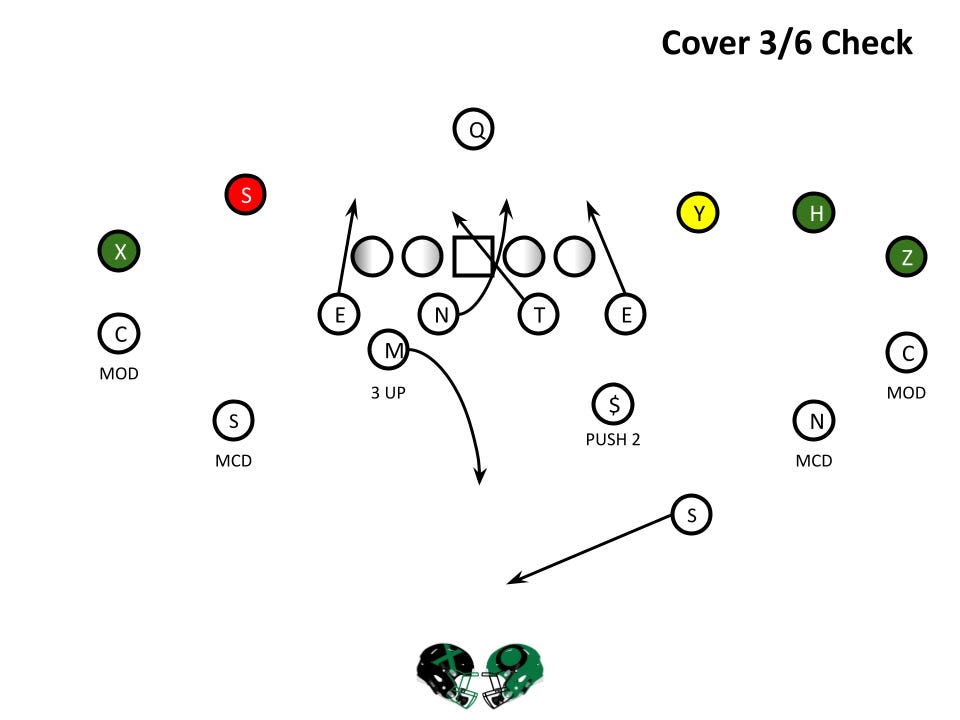Defending Empty Formations
Much like our article on Blitzing the TE, we like to write about our failures or shortcomings and the journey to overcome them in future games. Defending empty has certainly been one of these hurdles, but not in the way you’d think it would.
Early in my career we faced off against an opponent we heavily outmatched. Their answer, get into empty formations as much as possible and hope for the best. Like everyone we had empty checks, but we only had two, our split-zone coverage and a 6-man pressure with blitz coverage. So, our game became either bring the house or drop everyone. Not only did this make our defense very predictable, but it also made the game incredibly boring for the players and myself as a play caller. I’m not saying boring is bad, but when players get bored busts can happen.
Coverage ✓
Our first checks are coverage checks, meaning we’re dropping seven. In our nickel defense we likely play one of two coverages. The first is our Cover 7 (split-safety) check. We’ll make a trips check and a two receiver check and play normal split-safety coverage. The only difference is we’ll automatically make a stunt call up front to the defensive line. We do this because our interior backers are both typically in a “hip” alignment which is outside the box, and we’re trying to cancel gaps. The stunt is a week-to-week call based on the opponent. Below we’re playing “Stubbie” coverage to the trips and “Palms/ 2-Read” coverage to the twins.
Our other coverage check is when we’re in cover 3/6. In this check we’ll play our version of cover 6 skinny (weak rotation cover 3) where the corners, nickel and free safety all are playing match coverage. The two interior backers are responsible for pushing #2 and #3 up. We’ll still leave on some sort of weekly stunt up front, again designed to cancel gaps.
Cover 7 Pressure ✓
In a prior article we explained cover 7 pressures, which are pressures in which we bring one player weak, play a quarters concept strong, and man coverage weak. Any time we call this type of pressure and we get an empty set, we automatically check “Bingo”. Again the concept is match coverage strong and man weak, but we want to present the pressure coming from the strong side to attract the offensive line’s slide. Hopefully this gives our backer weak an open lane to rush the quarterback.
Fire Zone ✓
Our fire zone check is very similar to the “bingo” check, but now we’re going to play 3 under, 3 deep coverage with it.
6-Man ✓
Our 6-man empty check is derived from Venables’ “Purple Miami” call except we only drop the interior backers. The backers rules are if the offensive line makes contact then you drop into the hook. In theory you can drop every person in the pressure that gets contact from the offensive line and still have a free hitter, but at the high school level we only let our backers make this read.
Quads ✓
In cover 7, if the offense push motions the running back pre-snap to the trips (4 strong) then we will trigger the nearest interior backer for the running back and the opposite backer will replace his responsibility, posting #3. The backside safety will play whatever our backside call is. Our other option is to super rotate the safeties and play a version of “Stubbie” with four defensive backs, which allows us to leave the backers in the box.
In Cover 3/6 we are forced to run a version of 3 Cloud. In essence we’ll play “Clip” (Version of Match Cover 2) to the trips, and play Rip/Liz to the single creating a 3 Cloud look. It might not be the best solution, but it’s the one we devised. (If you have one better send it to me!)
Conclusion
Offensive coaches are better than ever at putting defenses in stressful situations. Having multiple ways to play formations and attack them can help reset the balance. As a defensive coordinator you want to dictate to the offense, so having multiple ways to attack formations is conducive to winning that battle.
If you have any questions about this article or any other football questions, please reach out to us at TheBoardDrillPodcast@gmail.com or DM us on X (formerly known as Twitter) @BoardDrillPod.













